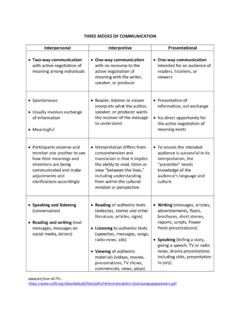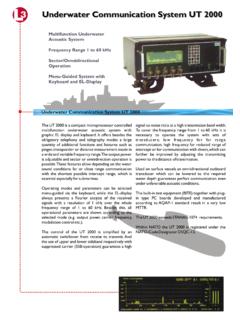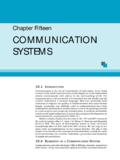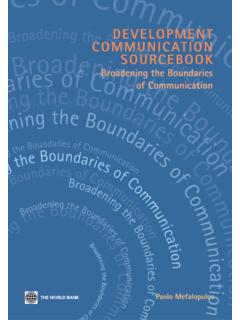Transcription of Classroom Communication - PEN-International
1 1 ClassroomCommunicationSidney M. BarefootSidney M. BarefootAssociate ProfessorAssociate ProfessorNTID at RITNTID at RIT2 Workshop TopicsThe Importance of Classroom Communication The Importance of Classroom Communication Strategies to Prepare for Strategies to Prepare for Classroom Communication DiversityClassroom Communication DiversityStrategies for Responding to Strategies for Responding to Classroom Communication DiversityClassroom Communication DiversityApplying Strategies to Applying Strategies to Specific Communication SituationsSpecific Communication SituationsA Professional Development ChecklistA Professional Development Checklist3 The Importance of Classroom Communication4 The Communication of Deaf Students Can Be Diverse LanguageLanguage ModalityModality Cultural identityCultural identity
2 GenderGender Emotional influencesEmotional influences Physical influencesPhysical influences5 Students value learning with their Communication strengths Access to visual informationAccess to visual information6 Students value learning with their Communication strengths Opportunity to use their residual hearingOpportunity to use their residual hearing7 Deaf and hard of hearing students value learning with their Communication strengths Use of their strongest languageUse of their strongest language8 When Communication is Learning is easierLearning is easier Goals are more likely to be metGoals are more likely to be met Opportunities emerge for expanded learningOpportunities emerge for expanded learning Students and faculty connect betterStudents and faculty connect better More positive perceptions influence the More positive perceptions influence the overall college experienceoverall college experience9 The Challenge To create a Classroom environment where To create a Classroom environment where Communication issues are openly Communication issues are openly recognized and managed in a way that recognized and managed in a way that promotes to Prepare for Classroom Communication Diversity11 Strategy 1.
3 Assess and develop your own Communication skills and knowledge Sign language proficiency Sign language proficiency Spoken language proficiency with deaf and hard Spoken language proficiency with deaf and hard of hearing peopleof hearing people Ability to adapt written language to promote Ability to adapt written language to promote student learningstudent learning Knowledge of cultures and skills in intercultural Knowledge of cultures and skills in intercultural communicationcommunication Knowledge of hearing aids, cochlear implants, and Knowledge of hearing aids, cochlear implants, and assistive technologyassistive technology12 Strategy 2: Learn more about each student s Communication before the course begins. Reading and writing characteristicsReading and writing characteristics Sign language type and proficiencySign language type and proficiency Speech and speech reception abilitiesSpeech and speech reception abilities Cultural background Cultural background Hearing aid/cochlear implant use Hearing aid/cochlear implant use Readiness to use assistive technologyReadiness to use assistive technology13Do you need a break?
4 14 Strategies for Responding to Classroom Communication Diversity15 Factors Seen in Successful Management of Communication Diversity Shared understandings of the Communication Shared understandings of the Communication situation while also respecting confidentialitysituation while also respecting confidentiality Openly discussed descriptions of the value of Openly discussed descriptions of the value of diversitydiversity StudentStudent--faculty cofaculty co--participation in the participation in the management of communicationmanagement of Communication Effective use of college resourcesEffective use of college resources Trust and respectTrust and respect Students who bridge othersStudents who bridge others Communication Communication toward a more effective group processtoward a more effective group process Other teamwork among studentsOther teamwork among students16 Strategy 1: Begin each course with a preliminary plan for Communication success Base plan on your preliminary knowledge Base plan on your preliminary knowledge of studentsof students Communication skills and needscommunication skills and needs17 Strategy 2.
5 Informally evaluate Classroom Communication dynamics Look for Communication similarities and Look for Communication similarities and diversity among studentsdiversity among students Determine if your preliminary Determine if your preliminary understandings of students were accurateunderstandings of students were accurate Determine if student patterns appear to be Determine if student patterns appear to be assets and/or challengesassets and/or challenges18 Strategy 3: Evaluate writing samples Collect academic writing and informal Collect academic writing and informal writing (ewriting (e--mail, TTY, etc.)mail, TTY, etc.) Compare written Communication clarity Compare written Communication clarity with other Communication modeswith other Communication modes Determine if writing tutoring or other Determine if writing tutoring or other support is neededsupport is needed19 Strategy 4: Ask the students to describe Communication Use questionnaires for selfUse questionnaires for self--description of description of Communication strengths and needscommunication strengths and needs Ask students what they are seeing in the Ask students what they are seeing in the Classroom dynamicsclassroom dynamics Ask students what they would like to do to Ask students what they would like to do to make Communication more effectivemake Communication more effective20 Strategy 5.
6 Adjust the Classroom environment as needed Adjust lighting, seating, acoustics, lighting, seating, acoustics, etc. Adapt visual presentation for visually Adapt visual presentation for visually restricted studentsrestricted students21 Strategy 6: Establish Communication rules and guidelines Remind everyone that Communication is highly Remind everyone that Communication is highly valued in the classroomvalued in the Classroom Explain how rules can help students learn togetherExplain how rules can help students learn together Use group discussion to develop Communication Use group discussion to develop Communication guidelinesguidelines Set limits on rules and accommodations as neededSet limits on rules and accommodations as needed Periodically ask students to assess Communication Periodically ask students to assess Communication and adapt guidelines as neededand adapt guidelines as needed22 Strategy 7.
7 Use technology to support Communication InIn--class mediaclass media Computerized interaction (studentComputerized interaction (student--student student and studentand student--faculty)faculty) EE--mailmail Online discussionsOnline discussions Online class notes and supplementsOnline class notes and supplements OtherOther23 Strategy 8: Make other special accommodations Allow more time on taskAllow more time on task Meet with students individuallyMeet with students individually Refer students to tutoring and other support Refer students to tutoring and other support activitiesactivities24 Need a rest?You can go outYou can go please come back!but please come back!25 Applying Strategies to Specific Communication Situations26 NTID Situation 1: The DistracterThe Distracter 27A student usually comes into class and takes his seat without speaking to or looking at the professor.
8 During the lecture part of the classes, he frequently initiates conversation with students sitting nearby, using sign without voice. When the professor indicates that that is not acceptable behavior because it distracts attention from the lecture, the student is quiet for a few minutes and then begins to converse again. A few other students do not seem to mind this and often participate in these private conversations. By the end of the third week, none of the students has approached the professor to complain and most students grades seem to be within the normal range. However, the professor is completely irritated and angered by this and Techniques for The Distracter What challenges or problems do you see in What challenges or problems do you see in this situation?
9 This situation? In what ways can this student provide a In what ways can this student provide a valuable contribution to this course?valuable contribution to this course? What additional information would help What additional information would help you better understand this situation?you better understand this situation? How would you respond to this situation?How would you respond to this situation?29 NTID Situation 2: The NonThe Non--SignerSigner 30 One male student in a class of twenty students uses speech and a little signing that he learned recently. He knows that the professor is a hearing person. As the first class begins, he volunteers information more than anyone in class. He uses speech but also adds some signs and fingerspelling. He takes a lot of time planning his signing and his Communication is extremely slow.
10 Several students express appreciation for this man trying to sign, but they also say it s difficult to understand him. The student who is learning to sign says he is not getting his thoughts out when signing and he is not doing very well understanding those who use sign language without voice. He asks the instructor to sign interpret when he speaks and voice interpret for the and Techniques for The Non-Signer What challenges or problems do you see in What challenges or problems do you see in this situation?this situation? In what ways can this student provide a In what ways can this student provide a valuable contribution to this course?valuable contribution to this course? What additional information would help What additional information would help you better understand this situation?





